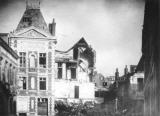St. John's - more
The photograph shows a part of the college at the end of World War I.
In four small unpublished books Fr. Dehon describes in a much more personal and detailed way than he does in the Notes Quotidiennes what happened in Saint-Quentin from 1914 until the evacuation in 1917. Under the title "St. John [college] the Instituion" we read:
"During that time, what became of our dear house of St-Jean? The part leading to the Rue des Arbalétriers remained intact; there were pupils there until the morning of the evacuation. The lower part, on the Ruet Antoine Lécuyer, became an infirmary for the poor soldiers whose brains were shaken by the shooting of the guns and canons. In other words, it was a lunatic asylum! The Germans had arranged it according to their taste. They built barracks for the kitchen and canteen in the court and they soon removed the partitions in the classrooms in order to build a dormitory.
The chapel remained open for a long time for worship, but the Protestants worshipped there alternatively with the Catholics. In the end the poor chapel became a barracks. The 'Michel' house was used for sick officers. Mr. Ronchaussé did what he could in his reduced quarters. Classes went on everywhere: salon, library, rooms of the professors. There were up to a hundred pupils. Two professor priests... several laymen.
The German professor, Mr. Kielwasser served often as interpreter to settle disputes.
The German chaplain was said to be inspector of the schools and came to see what was going on.
Catechisms was taught, too. Mr. Ronchaussé held a retreat for the pupils on the occasion of their return and two retreats for First Communion in the Chapel of the Sacred Heart.
There were hours of anguish and fear. Several times they returned to us what had been left in the infirmary.
Several professors, more nervous than others, were often unnerved. They went to the cellar a soon as they heard the sound of the planes or the thunder of the bombs.
Mr. Ronchaussé established an oratory in my old office on the first floor. I prayed there with great emotion."
(AD, Inv.: 0067600, probably written after the evacuation of Quentin Saint in 1917)
